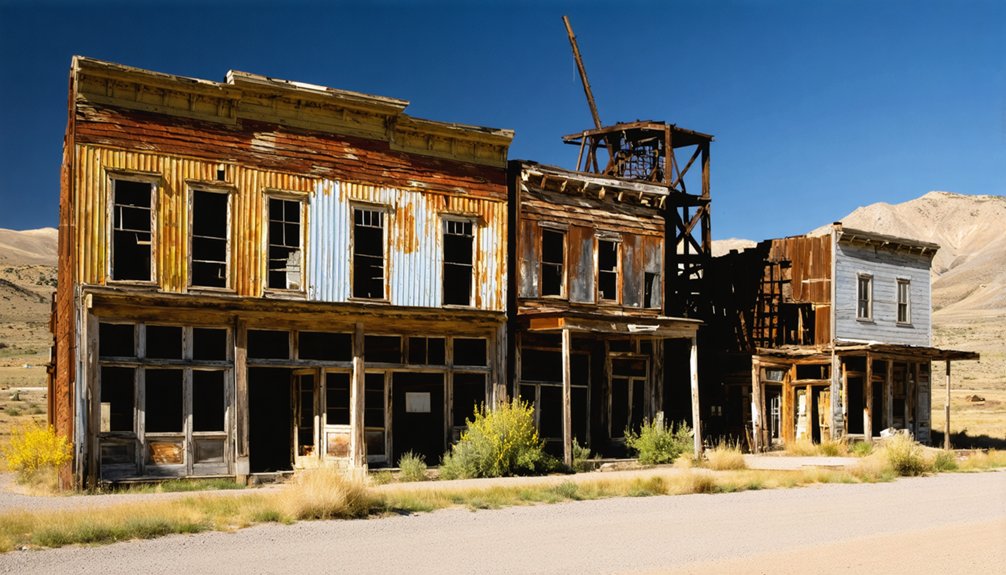Goldfield, Colorado emerged after gold’s discovery at Portland Mine in 1894, quickly transforming from pasture to a thriving community of 3,500 by 1900. You’ll find a town shaped by $30 million in gold production, violent labor disputes, and architectural diversity ranging from miners’ cabins to Victorian homes. Though mining operations ceased and population declined, preservation efforts since the 1990s have revitalized this historic site as a tourist destination showcasing Colorado’s mining heritage and frontier legacy.
Key Takeaways
- Goldfield was established in 1894 after gold discovery at Portland Mine, growing to 3,500 residents by 1900.
- The Portland Mine generated $30 million in gold and was the economic cornerstone of Goldfield.
- Abandoned after mining operations ceased, many historical structures were left behind when resources depleted.
- Preservation efforts began in the 1990s through the Goldfield Restoration Association to save historic buildings.
- Now a tourist destination, visitors can explore reconstructed buildings and exhibits showcasing Colorado’s mining heritage.
The Birth of a Mining Boomtown (1895-1900)
When gold was discovered at the Portland Mine in 1894, it sparked the rapid establishment of Goldfield, a mining boomtown that would become one of the largest settlements in Colorado’s Cripple Creek District.
The founders’ vision began with James Doyle, James Burns, and John Harnan, who initially named their claim “Gold Knob” before changing it to Goldfield in January 1895.
You’d have witnessed the Gold Knob Mining and Townsite Company transforming a fire-cleared pasture into a bustling community.
Burns directed street layouts while selling lots at $25 each. Mining infrastructure quickly developed, with board sidewalks and water ditches serving each property.
By 1900, the population had swelled to 3,500, and property values remained affordable at $100-$150 for a house and lot.
The town’s level terrain proved ideal for ore processing and transportation. The Portland Town & Mineral Company officially platted the town on August 4, 1894, with an impressive capital of $150,000. The newly established town soon had its own post office, which opened on May 5, 1895, when Goldfield was proudly referred to as the City of Homes.
Golden Years: When Ore Was King
At the zenith of Goldfield’s prosperity, you’d find the Portland Mine generating an astonishing $30 million in gold, making it the district’s crown jewel amid the economic powerhouses that transformed the region. The town emerged during the Cripple Creek discoveries of the 1890s that revitalized Colorado’s gold fortunes and economy.
You might’ve witnessed the tension between mine owners and laborers erupting into significant labor conflicts that shaped both the town’s social dynamics and the broader history of American mining unionization. These tensions eventually culminated in events like the Ludlow Massacre of 1914, which became a turning point for labor rights in Colorado’s mining industry.
Your visit to Goldfield during this era would have revealed an unexpected refinement among the industrial landscape—a collection of well-appointed residences earning it the moniker “City of Beautiful Homes,” challenging stereotypes of crude mining settlements.
Portland Mine’s $30 Million
The Portland Mine‘s staggering $30 million gold production firmly established it as the “Queen of the District” within the Cripple Creek Mining District‘s hierarchy of wealth-generating operations.
Discovered in 1894 by James Doyle, James Burns, and John Harnan, this remarkable operation reached depths of 3,300 feet in its relentless pursuit of precious ore.
You’ll appreciate how the Portland’s economic impact transformed the region, contributing considerably to the district’s impressive 21 million ounce yield by decade’s end.
The mine’s founders, inspired by Portland, Maine, strategically developed both the operation and the adjacent Goldfield townsite through their Portland Town & Mineral Company.
With $150,000 in capital investment, they orchestrated a structured community where you could purchase surface rights to lots for $25, while mining claims preserved underground wealth.
Historical records show the site produced an impressive $25,485,000 worth of gold extraction value during its operational years.
Even legendary heavyweight boxing champion Jack Dempsey once worked in the Portland Mine before rising to fame in the boxing world.
Labor Wars Legacy
Labor strife fundamentally altered Goldfield’s trajectory during the tumultuous Colorado Labor Wars of 1903-1904, transforming the mining community into a contested battleground between organized workers and powerful mine owners.
As you explore this ghost town today, you’re walking through the aftermath of significant labor rights struggles. The Western Federation of Miners employed sophisticated union strategies here—organizing not just miners but also cooks, teamsters, and clerks to enhance solidarity. These labor disputes were characterized by unprecedented employer violence as mine owners ruthlessly attempted to suppress worker organization. The conflict echoed earlier tensions from the 1894 Cripple Creek strikes when similar labor disputes had erupted in the region.
Goldfield’s strategic importance as a transit hub handling 20,000 tons of ore annually made it central to the conflict.
Outside town limits, National Guard troops established notorious “bull pens” to detain striking workers. Despite being less documented than conflicts in Cripple Creek and Victor, Goldfield’s labor wars represent a critical chapter in America’s turbulent fight for workplace dignity.
City of Beautiful Homes
Following Goldfield’s tumultuous labor struggles emerged a remarkable period of civic prosperity and architectural distinction that earned the settlement its reputation as a “City of Beautiful Homes.”
Unlike neighboring mining camps known primarily for their saloons and boarding houses, Goldfield developed into a sophisticated residential community where miners and their families established permanent roots.
You’ll find residential diversity reflected in the architectural landscape, from humble miners’ cabins to elaborate Victorian homes that sold initially for just $25 per lot. The town flourished rapidly as the Portland Mine’s production generated tremendous wealth for the community within its first two decades.
Community pride manifested through well-kept properties with manicured lawns and clean wooden sidewalks. The Gothic town hall, Clark’s Opera House, and multiple churches further distinguished Goldfield from wilder settlements like Altman.
Prominent citizens like Charles Sprague contributed to the town’s prestige with impressive residences such as “The Gables,” which hosted the first D.A.R. meeting in Nevada during February 1910.
Labor Wars and Social Unrest
As tensions mounted between workers and mine owners in the early 1900s, Goldfield found itself entangled in one of America’s most violent labor conflicts—the Colorado Labor Wars.
While visiting, you’ll be walking on ground where intense labor unrest once erupted, with the Western Federation of Miners militantly fighting for workers’ rights against powerful mine operators.
Though Goldfield proper experienced limited strike activity within town limits, the surrounding area became a battleground for miner solidarity.
Just outside town, a “bull pen” imprisoned striking workers during martial law. Jack Ried, who later became town marshal, suffered injuries during these confrontations.
The National Guard occupied the region with over 1,000 troops by September 1903, enforcing martial law to protect non-union labor and break strikes through intimidation, imprisonment, and force.
Daily Life in Early Goldfield
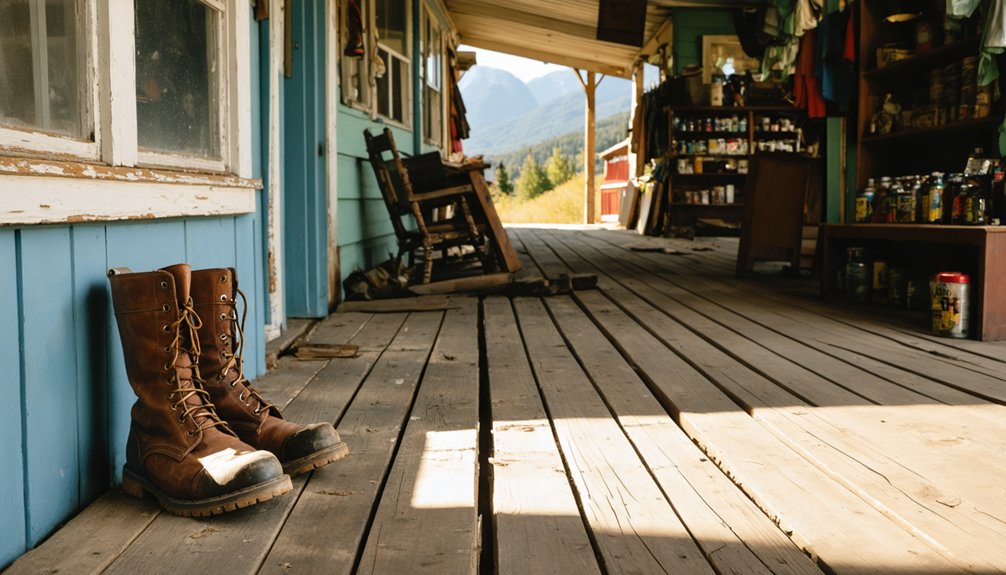
While the violent labor disputes shaped Goldfield’s historical narrative, daily life in this thriving mining community revolved around a surprisingly structured and family-oriented society.
You’d find residents investing in well-maintained homes, earning Goldfield its “City of Beautiful Homes” moniker—a stark contrast to typical ramshackle mining camps.
Daily necessities were readily available at the general store, meat market, and brewery. Social gatherings frequently occurred in the town’s three saloons, while churches hosted religious services and community events.
The schoolhouse served as an educational hub, reinforcing the town’s commitment to family stability despite its mining-focused economy.
With a peak population of 3,500, Goldfield’s infrastructure—including blacksmith shops and boarding houses—supported both permanent residents and transient workers while the Portland Mine’s $30 million gold production funded this vibrant community.
Architectural Heritage of “The City of Beautiful Homes”
If you walk Goldfield’s streets today, you’ll notice the architectural diversity that earned it the moniker “City of Beautiful Homes,” from ornate Victorian residences and French Provincial-influenced houses to simpler miner cabins built on narrow 25-foot lots.
The town’s aesthetic was carefully regulated through ordinances that guaranteed wooden sidewalks remained clean, yards were maintained, and even utility poles were painted in standardized black and white schemes.
Despite the town’s decline, several significant structures including the two-story clapboard City Hall with its distinctive bell tower and the historic Fire Station remain as architectural landmarks to Goldfield’s meticulously planned mining community heritage.
Architectural Style Flourishes
The architectural landscape of Goldfield earned it the fitting moniker “The City of Beautiful Homes,” showcasing a remarkable blend of Victorian and French Provincial styles amidst typical miners’ cabins.
Despite the rugged mining environment, residents created sophisticated dwellings on modest 25-foot lots, reflecting both prosperity and aesthetic aspirations.
Victorian influences manifested through:
- Ornate decorative trim and asymmetrical facades
- Multiple gables and elaborate detailing characteristic of late 19th century design
- Well-maintained lawns enhancing the structural elegance
- French elegance through steeply pitched roofs and tall, narrow windows
This architectural diversity represented more than mere aesthetics—it symbolized Goldfield’s economic success from the Portland Mine and other operations.
While nearby towns remained primitive, Goldfield’s residents invested in permanent structures that reflected stability and community pride.
Homes Through Time
Homes in Goldfield evolved considerably throughout the town’s history, transforming from hastily constructed miners’ cabins in the mid-1890s to more permanent family dwellings as the settlement prospered.
These wooden-framed structures, often built on lots with surface rights only, formed the backbone of what became known as the “City of Homes.” Despite their modest origins, residences displayed remarkable community pride with well-maintained lawns and modern amenities like wooden sidewalks.
The residential landscape clustered around Victor and Independence Avenues in a compact grid that facilitated social interaction.
However, when mining operations ceased, many homes were abandoned, succumbing to decay, theft, or burial beneath mining waste.
Today, preservation efforts by the Goldfield Restoration Association have salvaged select historic structures, creating interpretive trails that showcase the architectural heritage of this once-thriving mining community.
The Slow Fade: Causes of Goldfield’s Decline
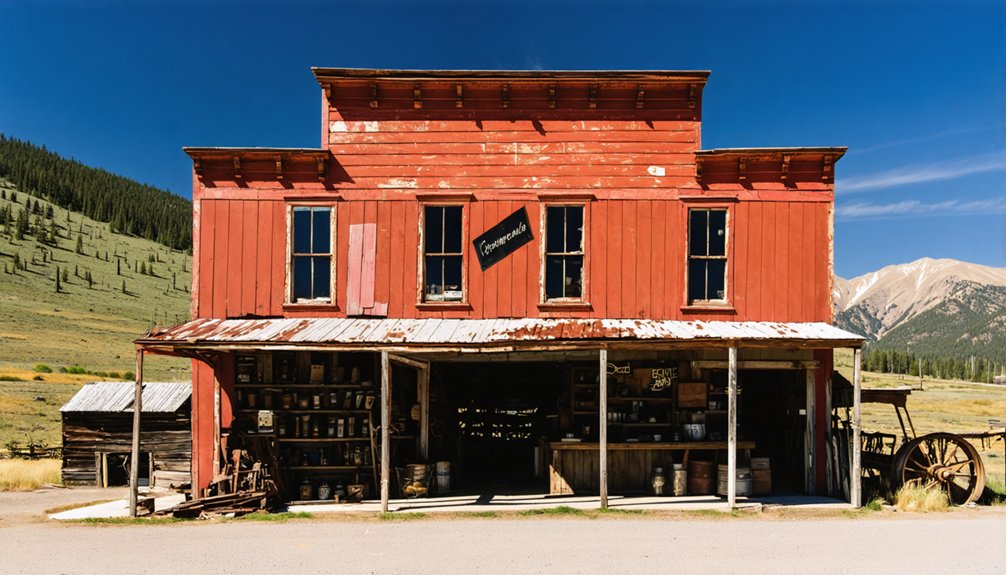
While many mining boomtowns experienced sudden collapses, Goldfield’s descent into ghost town status followed a more gradual trajectory driven by interconnected economic and social factors.
You’ll find that Goldfield’s decline wasn’t simply about exhausted gold veins but a complex tapestry of challenges:
- Resource depletion – The Portland Mine’s diminishing profitability epitomized the region’s fundamental problem: accessible gold ore became increasingly scarce and expensive to extract.
- Labor conflicts – Persistent tensions between unionized workers and mine owners disrupted operations and deterred new investment.
- Economic stagnation – As mines closed, supporting businesses followed, creating a downward spiral of unemployment and outmigration.
- Infrastructure limitations – Without diversification beyond mining or significant transportation improvements, Goldfield couldn’t compete with better-connected neighboring communities during regional economic shifts.
Ghost Town Years: 1932-1970
As Goldfield’s economic decline accelerated beyond reversal, June 1932 marked a definitive moment in the town’s transformation from struggling mining community to authentic ghost town—the official closure of its post office.
You’d find approximately 35 stubborn souls remaining by 1969, inhabiting structures gradually surrendering to nature. Wooden sidewalks rotted away while abandoned buildings swayed precariously before collapsing into weeds.
The Portland Mine’s unprofitable operations had ceased, and the Cripple Creek Times Record stopped publishing Goldfield news after 1939.
Ghost town artifacts, including the imposing City Hall safe with “City of Goldfield” etched in gold leaf, stood as silent witnesses to former prosperity.
Resident memories faded from regional consciousness as historical documentation was stolen and sold online, leaving Goldfield largely forgotten until its official ghost town designation in 1969.
Rebirth as a Tourist Destination
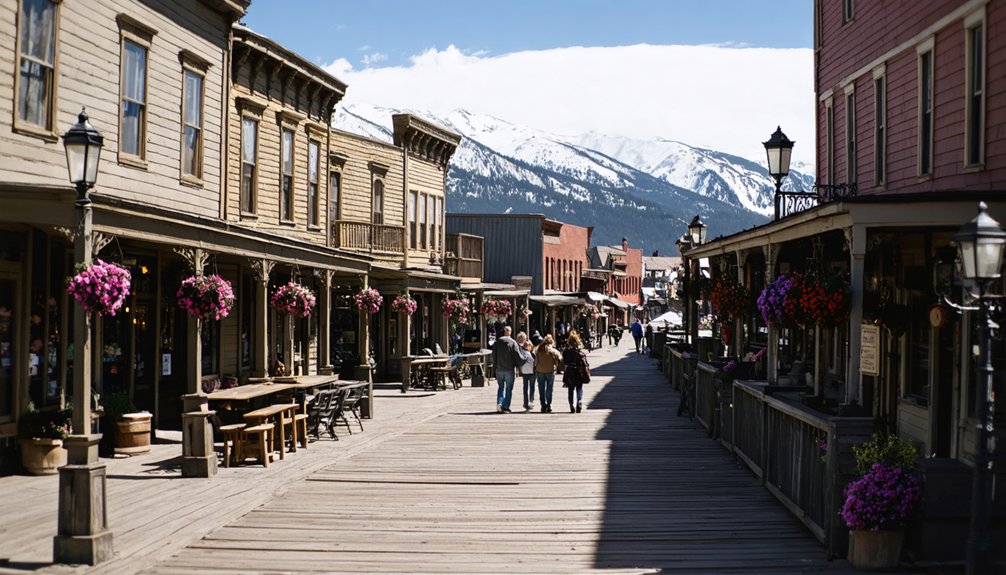
Following decades of abandonment, Goldfield experienced a remarkable transformation beginning in the 1990s when preservation efforts coalesced into a coordinated tourism strategy.
The Goldfield Restoration Association spearheaded community engagement initiatives to preserve historic structures while maintaining architectural integrity.
Tourism strategies implemented by local stakeholders generated sustainable economic opportunities through heritage-based attractions.
When you visit Goldfield today, you’ll find:
- Restored landmarks including the city hall and fire station that showcase authentic mining-era architecture
- Interpretive infrastructure such as the Vindicator Valley Trail offering immersive historical experiences
- Community-driven festivals and reenactments highlighting the town’s union history
- Local businesses operated by residents who actively participate in preservation projects
This revitalization has positioned Goldfield as a significant cultural destination, creating jobs while preserving Colorado’s mining heritage.
Exploring Today’s Goldfield Ghost Town
As you wander through Goldfield’s reconstructed attractions, you’ll notice the gothic town hall standing amid collapsed structures and deteriorating homes that offer poignant testimony to Colorado’s gold rush era.
Photography enthusiasts can capture compelling contrasts between preserved buildings and the surrounding mountainous landscape dotted with abandoned mining equipment visible from the trail system.
Various tour options allow you to examine remaining historical elements including Rufus Porter’s protected cabin and glimpse the foundations that raise intriguing questions about this once-thriving community of 50,000 residents.
Reconstructed Attractions Today
While Goldfield’s historical significance lies in its authentic ruins and original structures, today’s visitors can experience a thoughtfully reconstructed ghost town environment that balances preservation with accessibility.
Spanning 90 acres, this partial ghost town offers glimpses into the 1895 mining era while respecting the approximately 50 current residents who call it home.
When exploring the reconstructed buildings and historical exhibits, you’ll find:
- Original wooden storefronts representing authentic late 1800s mining town architecture
- Residential structures from the once-called “City of Beautiful Homes” in various preservation states
- Educational displays highlighting the Portland Mine’s $30 million gold production
- Year-round access via paved highways, with fall offering ideal exploration conditions
These features allow you to freely wander through Colorado’s gold rush history while respecting private property boundaries.
Photography and Tour Options
Goldfield’s photographic opportunities extend far beyond casual snapshots, offering serious photographers and history enthusiasts a rich tapestry of visual documentation possibilities throughout the 90-acre historic landscape.
Position yourself on County Road 81 for dramatic compositions featuring City Hall against mountain backdrops, or ascend to Little Theresa Mine for compelling aerial perspectives. The Vindicator Valley Trail provides intimate access to mining relics in their authentic state.
When planning tours, you’ll benefit from year-round accessibility via paved highways regardless of seasonal conditions.
Implement respectful photography techniques when documenting abandoned structures, as approximately 50 residents still occupy portions of the property.
Consider both golden-hour lighting and winter conditions for distinctive documentation of Gothic-style architecture, scattered mining equipment, and deteriorating ruins—all telling different chapters of Goldfield’s compelling story.
Preserving Colorado’s Mining Legacy
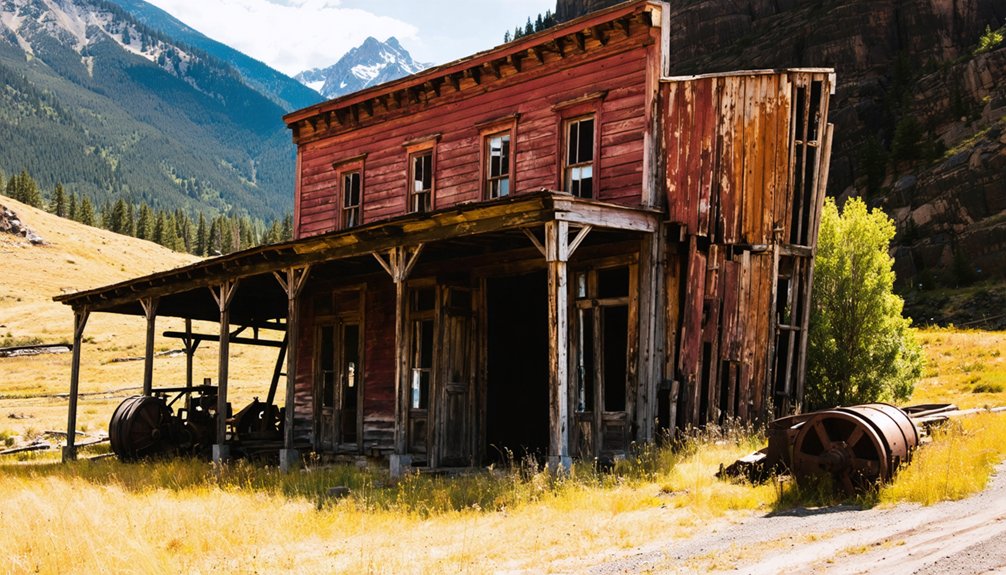
Preserving Colorado’s mining legacy remains a multifaceted challenge that balances public safety concerns with historical conservation imperatives. Since 1859, mining has shaped Colorado’s development, leaving behind approximately 23,000 hazardous features that require careful mitigation.
Historical restoration efforts operate under limited funding—only $2 million annually from coal mining fees supports the Abandoned Mine Reclamation Program.
When visiting mining ghost towns like Goldfield, you’ll appreciate these preservation efforts that:
- Seal dangerous mine shafts while maintaining historical integrity
- Document mining operations through archived reports dating from 1900-1980
- Digitize historical mining photographs and documents for public accessibility
- Balance safety requirements with cultural significance of mining districts
Mining preservation succeeds through strategic partnerships between government agencies, historical organizations, and local communities committed to safeguarding this vital chapter of Colorado’s frontier heritage.
Frequently Asked Questions
What Happened to Goldfield’s Original Inhabitants After the Decline?
You’re witnessing a stark contrast: while inhabitant migration dispersed Goldfield’s population to active mining regions after 1897, community resilience emerged elsewhere as families relocated seeking alternative employment when gold depletion eliminated opportunities.
Are There Any Paranormal Activities Reported in Goldfield?
While Goldfield itself has limited documented ghost sightings, nearby Cripple Creek hosts numerous paranormal investigations. You’ll find more substantiated supernatural phenomena there, though local legends suggest mining spirits linger throughout the entire district.
How Did Prohibition Affect Goldfield’s Saloon-Heavy Economy?
You’d think shutting down nine lively saloons would strengthen a town; ironically, it devastated Goldfield. Saloon closures accelerated economic decline, eliminating tax revenue, jobs, and community hubs that once defined the vibrant mining settlement.
What Indigenous Peoples Inhabited the Area Before Mining Began?
Before mining, you’d find Ute people as the region’s oldest inhabitants, with Arapaho and Cheyenne tribes later occupying the eastern plains—creating a complex indigenous history with significant cultural impact despite territorial conflicts.
Has Goldfield Ever Appeared in Movies or Television Shows?
Yes, you’ll find Goldfield featured in “Ghost Adventures” television series’ Apache Junction episode and the horror film “Ghosts of Goldfield.” Various YouTube documentaries continue showcasing this historic mining town’s cinematic appeal.
References
- https://www.ajpl.org/building-a-dream-goldfield-ghost-town/
- https://westernmininghistory.com/towns/colorado/goldfield/
- https://www.uncovercolorado.com/activities/goldfield-ghost-town/
- https://goldfieldghosttown.com
- https://www.ghosttowns.com/states/co/goldfield.html
- https://coloradostories.online/f/a-colorado-gold-adventure
- https://en.wikipedia.org/wiki/Goldfield
- https://www.victorcolorado.com/WebGuide.pdf
- https://www.victorheritagesociety.com/reflections-on-goldfield-by-carol-roberts.html
- https://janmackellcollins.wordpress.com/category/goldfield-colorado/
